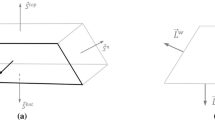Abstract
A model for surface irrigation is developed that allows the determination of the vertical structure of the velocity profile in the vicinity of the wave front. The pressure is not assumed to be hydrostatically distributed and no assumptions are made regarding the shape of the freesurface profile. The turbulent kinetic energy and rate of dissipation are computed by a two-equation model and accurate determination of the bottom shear makes possible the analysis of particle suspension. The model is based on a two-dimensional finite element model in the vertical plane and uses the kinematic condition for determining the position of the free surface. It also incorporates a numerical technique for describing surface penetration and wave breaking by combining a Lagrangian approach that allows the computational nodes to move individually and then automatically reshapes the element grid. The potential value of the model lies in its ability to provide information on vertical mixing, settling and suspension of contaminated solids commonly found in irrigation applications.
Similar content being viewed by others
References
Alfrink BJ, van Rijn LC (1983) Two-equation turbulence model for flow in trenches. ASCE J Hydr Engng 109: 941–957
Chapman RS, Kuo CY (1985) Application of the two-equation k-ɛ turbulence model to a two-dimensional, steady, free surface flow problem with separation. Inter J Numer Methods Fluids 5: 257–268
Finnie JI, Jeppson RW (1991) Solving turbulent flows using finite elements. ASCE J Hydr Engng 117: 1513–1530
Gibson MM, Rodi W (1989) Simulation of free surface effects on turbulence with a Reynolds stress model. J Hyd Res 27: 233–244
Harlow FH, Welch EJ (1965) Numerical calculation of time-dependent viscous incompressible flows of fluid with free surface. Physics Fluids 8: 2182–2194
Hood P, Taylor C (1974) Navier-stokes equations using mixed interpolation. Proceedings, International Symposium on Finite Element Method in Flow Problems, Swansea, Wales
Hughes TJR, Brooks A (1982) A theoretical framework for Petrov-Galerkin methods with discontinuous weighting functions: Application to the streamline-upwind procedure. Finite Elements Fluids 4: 47–63
Huh C, Scriven LE (1971) Hydrodynamic model of steady movement of a solid-liquid-air contact line. J Colloidal Interfacial Sci 35:85
Katopodes ND, Strelkoff T (1977) Hydrodynamics of border irrigation — complete model. ASCE J Irrig Drain Div 103: 309–324
Khesghi FJ, Scriven LE (1981) Penalty finity element method for time dependent incompressible free surface film flow. In: Kawahara M (ed) Finite elements in fluid flow problems. Tokyo, Japan
Kistler SF, Scriven LE (1983) Coating flow computations. In: Pearson JR, Richardson SM (eds) Computers in polymer processing. Applied Science Publishers Ltd, London
Leone JM, Gresho PM (1979) Finite element simulations of steady, two dimensional, viscous incompressible flow over a step. J Comput Phys 32: 312–348
Lynch DR, Gray WG (1980) Finite element simulation of flow with deforming regions. J Comput Phys 36: 2, Academic Press, New York
Miyata H (1986) Finite-difference simulation of breaking waves. J Comput Phys 65: 179–214
Ramaswamy B, Kawahara M (1987) Arbitrary lagrangian-eulerian finite element method for unsteady, convective, incompressible viscous free surface fluid flow. Int J Numeric Methods Fluids 7: 1053–1075
Rodi W (1988) Turbulence models and their application in hydraulics — a state-of-the-art review. International Association for Hydraulic Research, Delft, The Netherlands
Sakkas JG, Strelkoff TS (1974) Hydrodynamics of surface irrigation advance phase. J Irrig Drain Div 100: 31–48
Schamber RD (1979) Finite element analysis of flow in a sedimentation basin. Ph.D Dissertation, Dept of Civil Engin, Univ of California, Davis
Schlichting H (1979) Boundary layer theory. Translated by Kestin J, Seventh edn, McGraw-Hill Co, New York
Strelkoff T, Katopodes ND (1977) Border irrigation hydraulics with zero inertia. ASCE J Irrig Drain Eng 103: 325–342
Tang J-H (1991) Surge propagation on a porous bed. Thesis presented to the University of Michigan in partial fulfillment of the requirements of the degree of Ph.D
Tinney RE, Bassett DL (1961) Terminal shape of a shallow liquid front. ASCE J Hydraulic Eng 5: 117–133
Tsaras YG (1986) Finite element analysis of surge propagation on a porous bed. Thesis presented to the University of Michigan, in partial fulfillment of the requirements of the degree of Ph.D
Whitham GB (1954) The effects of hydraulic resistance in the dam break problem. Proc R Soc (London) Series A 227: 399–407
Author information
Authors and Affiliations
Rights and permissions
About this article
Cite this article
Katopodes, N.D. Hydrodynamics of surface irrigation: vertical structure of the surge front. Irrig Sci 15, 101–111 (1994). https://doi.org/10.1007/BF00187196
Received:
Issue Date:
DOI: https://doi.org/10.1007/BF00187196




